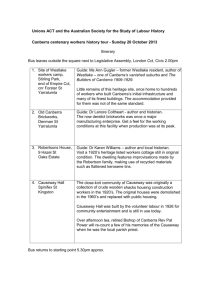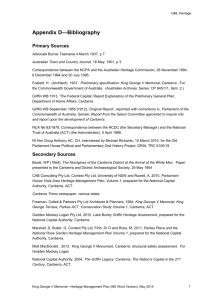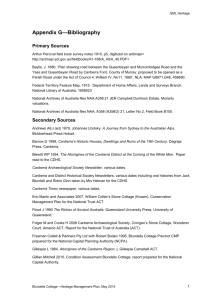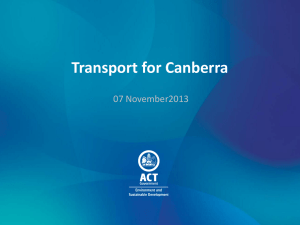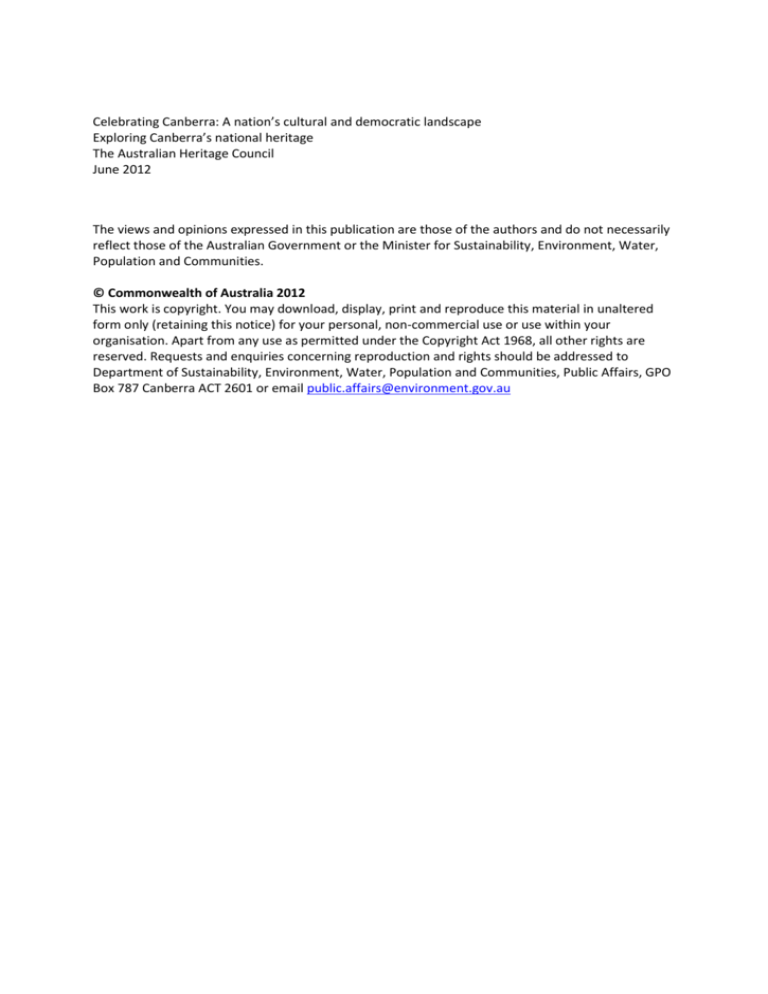
Celebrating Canberra: A nation’s cultural and democratic landscape
Exploring Canberra’s national heritage
The Australian Heritage Council
June 2012
The views and opinions expressed in this publication are those of the authors and do not necessarily
reflect those of the Australian Government or the Minister for Sustainability, Environment, Water,
Population and Communities.
© Commonwealth of Australia 2012
This work is copyright. You may download, display, print and reproduce this material in unaltered
form only (retaining this notice) for your personal, non-commercial use or use within your
organisation. Apart from any use as permitted under the Copyright Act 1968, all other rights are
reserved. Requests and enquiries concerning reproduction and rights should be addressed to
Department of Sustainability, Environment, Water, Population and Communities, Public Affairs, GPO
Box 787 Canberra ACT 2601 or email public.affairs@environment.gov.au
Foreword
The Australian Heritage Council is excited to be considering the national heritage significance of
Canberra in the national capital’s centenary year. Canberra is vital to all Australians as the heart of
our democracy and pinnacle of our justice system.
Born of the utopian ideals of the founders of Australian Federation and grounded in the Griffins’
visionary town plan, Canberra has grown to be one of the world’s great twentieth century cities.
Australia’s national heritage comprises exceptional natural and cultural places that contribute to
Australia’s national identity, from the Great Barrier Reef and the West Kimberley to Bondi Beach and
Sydney Opera House.
The National Heritage List identifies the critical moments in our development as a nation, it includes:
places that speak to us of exploration and settlement like the Batavia Wreck Site, Port Arthur and
Bonegilla Migrant Camp, mark iconic events such as the Eureka Stockade site and the Wave Hill Walk
Off Route, showcase creative achievements like the Adelaide Parklands and City Layout, or reflect
joys and sorrows in the lives of Australians.
It also encompasses those places that reveal the richness of Australia’s extraordinarily diverse
natural heritage, from remote ancient landscapes like Uluru/Kata Tjuta, resonant with meaning over
thousands of generations of Indigenous habitation, to Riversleigh’s fossil site or the natural beauty
of the Australian Alps and the Tasmanian Wilderness.
Several places within Canberra are already included on the National Heritage List: Old Parliament
House, the Australian War Memorial and Memorial Parade, the High Court-National Gallery Precinct
and the Australian Academy of Science Building. Many other places of local or territory significance
are included on the Commonwealth Heritage List or the ACT Heritage Register.
The Council is taking a broad and overarching approach in assessing the significance of Canberra as
the planned national capital. The proposed listing will capture those outstanding elements of
Canberra that contribute to the key themes of:
Canberra’s historical and symbolic significance as a new capital city established by the Australian
Constitution;
the city’s role in facilitating public engagement in the political process and as the site of
landmark decisions and national remembrance; and
Canberra as a showcase of cutting-edge twentieth century town planning ideas.
The Australian Heritage Council invites all Australians to engage with the national heritage
assessment of your national capital.
Dr Carmen Lawrence
Chair, Australian Heritage Council
May 2012
2
CANBERRA: 100 YEARS AT THE HEART OF THE NATION
In 2013 Australians will be celebrating the centenary of Canberra as the nation’s capital. The city
of Canberra, its inception and planning, embodies the development and evolution of Australia’s
unique cultural and democratic landscape.
As one of the world’s great twentieth century planned cities, the city of Canberra has represented
and reflected the political and cultural mood of the nation since Federation. Each Australian has
their own view and perception of Canberra, whether it is Canberra as the seat of government, the
home of parliament, a place for decision making, protest or national commemoration, reflection and
healing. Canberra’s natural landscape setting and the outstanding city design by Walter Burley
Griffin and Marion Mahony Griffin has also contributed to the creation of a city of great beauty. All
Australians can be proud of their national capital.
To celebrate Canberra’s centenary the Australian Heritage Council is undertaking a national heritage
assessment to determine if Canberra’s unique place in our nation’s history and heritage should be
given Australia’s highest heritage honour, a national heritage listing.
CANBERRA: ONE PEOPLE, ONE NATION, ONE DESTINY
‘The seat of Government of the Commonwealth shall be determined by the Parliament, and shall be
within territory which shall have been granted to or acquired by the Commonwealth, and shall be
vested in and belong to the Commonwealth, and shall be in the State of New South Wales, and be
distant not less than one hundred miles from Sydney.’
Section 125 Constitution of the Commonwealth of Australia (1901)
The concept for the city of Canberra emerged during the movement towards Federation in 1901.
Canberra was conceived as an ideal city, a nation’s capital worthy of the ideas, passion, values and
patriotism of the Federation movement. Today, Canberra is internationally recognised as an
outstanding example of twentieth century town planning and one of a few capital cities in the world
designed through an international town planning competition.
The selection of the place for the nation’s new national capital was debated vigorously and at length
as the nation moved towards Federation. Many assumed that either Melbourne or Sydney, as the
largest cities in the new nation, would become the capital. However, there were concerns that
consolidating economic and political power in one of the soon to be states could create unbalance
and bias within the new Federation. The decision about what and where the new capital should be
was ultimately embodied in the new nation’s Constitution.
A congress on the planning of the new federal capital held in Melbourne in May 1901 decided that
the capital ‘should be laid out in the most perfect manner possible’ and suggested the capital should
be decided by a design competition. Selection of the site for Canberra was finalised in 1909. The site
chosen was within a pastoral valley and a natural amphitheatre of hills, sheltered by the
northernmost ranges of the Australian Alps. It provided a striking setting for the new capital city.
After 137 entries, the inspirational designs of American architects, Walter Burley Griffin and Marion
Mahony Griffin, were chosen as the foundation for the new capital. The Griffins’ designs drew on the
‘city beautiful’ and ‘garden city’ town planning movements current at the time.
3
City Beautiful
The City Beautiful was a reform philosophy current in North American architecture and urban
planning circles during the 1890s and 1900s. The intent of the philosophy was to import Europeanstyle beautification and monumental grandeur into cities. The movement involved the promotion of
beauty not only for its own sake but as an uplifting moral and civic force for the community.
Advocates of the philosophy believed that such beautification could thus promote a harmonious
social order that would increase the quality of life.
Garden City
The Garden City movement was a style of urban planning that was initiated in 1898 by Sir Ebenezer
Howard in the United Kingdom. Garden cities were intended to be planned, self-contained
communities surrounded by “greenbelts” or parks containing proportionate areas of residences,
industry and agriculture. The concept of garden cities is to produce relatively economically
independent cities with short commute times and the preservation of the countryside.
The Griffins’ design also responded sensitively to the topography of the site, realising the potential
to place national monuments in a natural landscape to create symbols of democracy and evoke the
sense of a connection between a young city and the great civilisations of the past. Utilising a
geometry of circles, straight lines between axial points and a central triangle, the Griffins laid out
grand boulevards demarcating significant national spaces, a symmetrical central lake and grand
vistas. The Griffins’ outstanding design influenced the city plans for New Delhi and Brasilia.
Australian Architect Paul Reid considered the Griffins’ design as ‘one of the finest city plans ever
made’1, while John Reps, eminent American urban historian, stated that
Griffin’s vision ... remains an extraordinary achievement deserving recognition and protection as one
of the treasures, not only of Australia, but of the entire urban world.2
Even though subsequent Canberra city plans only retained the Griffins’ street pattern, a more
naturalistic interpretation of the lake (later named in his honour) and the location of the
government zone and civic centre on opposite sides of the lake was developed. The legacy of the
Griffins’ idealistic vision remains, however, clearly visible and popularly celebrated in the Canberra
landscape and continues to be echoed in the planning and design of new national buildings and
institutions added to the Canberra landscape.
The design of the 1988 Parliament House pays homage to the Griffins’ design by locating the building
within rather than on top of Capital Hill and reflecting the profile of the Griffins’ proposed people’s
Capitol building in the Parliament’s stepped retaining walls and iconic flagpole. The expansion of
Canberra reflects changes and developments in Australia’s political and cultural landscape. The postwar decision to relocate the public service to Canberra led, in the 1960s, to the development of
relatively self-contained ‘new towns’ in the valleys beyond the central amphitheatre, connected by
an intra-urban network of motorways. Refined during the 1970s and 80s, what became known as
the ‘Y Plan’ designed to maintain the central area of Canberra as a national showcase, retaining the
inner hills as natural green spaces and providing public amenity through a reinterpretation of the
original ‘garden city’ planning concept. The aesthetic relationship between the designed city and its
landscape setting is acknowledged by ongoing community appreciation of Canberra as the ‘bush
capital’.
1
Reid, P. 2002, ix
2
Reps, J.W. 1997 quoted in National Capital Authority
(NCA) 2004, vi
4
For almost a century Canberra has incorporated the latest innovations in design and social
innovation in town planning. From the early garden suburbs of the 1920s through experiments in
community town planning and early medium density town house developments to the late
twentieth century sustainable city ‘urban infill’ approach, Canberra has emerged as a world
renowned example of the layering, implementation and utilisation of significant twentieth century
town planning concepts. Planning historian Robert Freestone describes Canberra as
…an outstanding national outdoor museum of the world’s best practice in planning from the 1910s.3
As the seat of Australia’s robust democracy, Canberra reflects the ideals and values of the Fathers of
Federation and their ideal of ‘One people, one nation, one destiny’. The city of Canberra provides
the Australian community with public spaces for vibrant exchanges between the citizenry and their
parliamentary representatives. Canberra has been the site for momentous decisions and movements
of change that have impacted on the lives of all Australians. It has been the place for the declaration
of war and peace, the decision for equal rights and pay for women and the passing of the two
amendments to the Constitution arising from the referendum of May 1967 granting Indigenous
Australians citizenship and the right to vote in federal elections.
The 1972 Aboriginal Tent Embassy located in front of Old Parliament House played a pivotal role in
raising the profile of the land rights debate. Landmark decisions by the High Court related to the
Indigenous land rights of the Mabo and Wik legal cases took place in Canberra. Parliament House
and it’s grounds were the site for the National Apology to the Stolen Generations and the National
Apology to the Forgotten Australians and Former Child Migrants. These moments in our national
history continue to resonate today.
The heart of the nation is expressed through national commemorations held in Canberra. The
Australian War Memorial, standing at the head of the grand processional route within the Griffins’
monumental ‘Land Axis’ vista, is recognised as the pre-eminent national shrine defining the
Australian spirit. The Aboriginal Memorial housed in the National Gallery, Reconciliation Place and
the National Police Memorial in King’s Park may also be nationally significant.
In addition to federal politicians and Governors-general as a group several politicians have set
milestones in Australian democratic history such as the first woman or Indigenous person elected to
Parliament or serving in a significant role. A number of people who played a vital role in the
selection, creative design and planning of the national capital are also associated with Canberra.
These include politicians King O’Malley and Sir Robert Menzies, surveyor Charles Scrivener,
architect/designers Walter Burley Griffin and Marion Mahony Griffin, town planners John Sulman,
Sir John Butters, John Overall, Peter Harrison and William Holford, architect Romaldo Giurgola and
horticulturalists Charles Weston and Lindsay Pryor.
A national heritage listing would celebrate the outstanding physical features of the city and the
associations with significant people and major commemorative events that make Canberra one of
the world’s great capital cities.
CANBERRA: A NATIONAL HERITAGE ASSESSMENT
Each year the federal heritage minister seeks nominations for the National Heritage List. In 2009,
based on the theme of A Free and Fair Australia, two nominations for the City of Canberra were
received.
3
Freestone, R. 2010, 274
5
The nominations Canberra and Surrounding Areas and Canberra – Central National Area and Inner
Hills have different approaches to the interpretation of the national heritage values of a planned city
and this stirred the Australian Heritage Council to think about what particular attributes or aspects
of the development of the city are of potential national heritage value.
The Council is currently assessing the two nominations and also taking into account the recently
received third Canberra heritage nomination, Lake Burley Griffin and Lakeshore Parklands. In
comparison to Canberra’s existing national heritage listed places which represent particular
individual or singular historical, architectural, natural or social heritage, in examining the Canberra
nominations the Council is looking to discover the wider and more complementary national heritage
significance of Canberra.
In taking this approach the Council is challenging itself to define what the most important historical
and heritage elements of the design and landscape of Canberra are and if these together are of
outstanding heritage value to the nation. To do this the Council has established a number of
parameters for its assessment.
Canberra as a whole
The Council is taking a broad, overarching approach to the assessment of the national heritage
values of Canberra. It is looking at Canberra:
as an outstanding example of 20th century town planning;
for its significance as the nation’s planned capital city conceived at Federation and the city’s
development over 100 years of town planning theory and thought; and
as a landscape and expression of Australia’s democratic ideals.
The proposed national heritage listing will not supersede, replace, or provide a dual listing for
Canberra’s existing national heritage places but rather provide an umbrella under which existing
more detailed individual heritage listings can co-exist.
The Canberra – Central National Area and Inner Hills nomination
The Canberra – Central National Area and Inner Hills nomination proposes a relatively constrained
area that covers the inner historic area of central Canberra, including the Designated Areas
comprising the Central National Area (excluding the Airport precinct) and the Inner Hills part of the
National Capital Open Space System (the reserves associated with Black Mountain, Mt Ainslie, Red
Hill, Isaacs Ridge, Mt Taylor and Mt Stromlo), and the inner garden city suburbs gazetted in 1928
(Barton, Ainslie, Braddon, Deakin, Forrest, Griffith, Kingston, Reid, Turner and Yarralumla). It includes
all land within these areas, including commercial and residential lands.
The nomination highlights Canberra’s significance from its inception and early development and its
representation as an outstanding achievement in town planning and social idealism of the early
twentieth century. It also focuses on Canberra’s uniqueness and that it embodies contemporary
town planning principles of the day that were the focus of national and international expert thought
and practice.
Canberra as a planned city
The Council recognises that much of the significance of Canberra is related to its establishment as
Australia’s only consistently planned twentieth century capital city and the ongoing management
and development of the city through nearly a century of town planning theory and changing
architectural movements. This concept of the layering of town planning during the course of the
6
twentieth century is central to the Council’s assessment.
The Council acknowledges that the Griffin Plan was seminal to the establishment of Canberra,
however the city envisaged by the Griffins was only partially realised and so cannot be listed as a
place of national heritage significance. The Council however in its assessment recognises that the
original Griffin Plan shaped and continues to influence the city of Canberra. It also acknowledges
that the city owes it historical and present forms to a series of planning phases. The Council
considers that the national heritage significance of Canberra likely relates to the evolved planned
city. Rather than limiting the assessment to a cut-off date such as 1928, the assessment will cover
Canberra’s development until 1988, when self government split planning control between the
Commonwealth and ACT governments.
The Canberra and Surrounding Areas Nomination
The Canberra and Surrounding Areas nomination takes a broad view of what should be included to
represent the planned city. It includes the component of the Australian Alps National Parks and
Reserves National Heritage listing that is within the ACT (ie Namadgi NationalPark and Tidbinbilla
Nature Reserve); the Murrumbidgee and Molonglo Rivers corridors; all land within the Designated
Areas as defined in the National Capital Plan; the entire national capital open space system; the
whole of central Canberra excluding Fyshwick and North Watson; the idea of the metropolitan
structure of Woden/Weston, Belconnen, Tuggeranong and Gungahlin; the landscape context for the
peripheral parkways and landscape corridors; and main avenues and approach routes. It excludes all
land outside the public domain in the Designated Areas (ie excludes privately owned commercial and
residential land but includes features, parks or buildings in government ownership) except in the
case of some privately owned elements in the Garden City suburbs and in other prototype suburbs
in central Canberra planned and established by subsequent planning agencies up to 1984.
The natural landscape within and around Canberra
Parts of the Inner Hills that form elements of the national capital open space system, as defined in
the National Capital Plan, are critical components of the successive plans for Canberra, and have
been major determinants of the form and character of the city.
The outer hills and mountain ranges, including the Brindabella, Tidbinbilla and Bimberi Ranges within
Namadgi National Park and Tidbinbilla Nature Reserve, provide the backdrop setting for Canberra.
The proposed national heritage values acknowledge the orientation of the Land Axis in the Griffin
Plan towards Mt Bimberi and that distant vistas of the mountains provide an important component
in the outstanding aesthetic experience of the city.
However it is not proposed to include these areas within the boundary of the Canberra assessment
as it would unnecessarily duplicate the values of Namadgi National Park and Tidbinbilla Nature
Reserve as part of the Australian Alps National Parks and Reserves National Heritage listing without
adding to the planning or democracy themes of this assessment.
The Council also considers that while access to a reliable water supply was a factor in the selection of
the site for the national capital, much of the Murrumbidgee and Molonglo River Corridors are not
visible from Canberra and the river corridors do not have outstanding heritage value to the nation in
their own right.
7
What is the ‘place’ that is being assessed?
It is the central national area of Canberra, the Land Axis and Water Axis, Lake Burley Griffin, the
layout of the early garden city suburbs as defined in the 1925 Gazetted Plan, the Y-Plan road system
and the location of the new towns and the undeveloped inner hills that are reflected in the proposed
Canberra national heritage values. The place is not tied to particular buildings, road alignments or
town centre layouts and buildings.
Not wishing to duplicate existing national heritage listings in Canberra, only the heritage values of
those places relevant to Canberra as a planned city and the seat of national government are looked
at in this assessment.
THE HISTORY OF CANBERRA
The possible national heritage values of the city of Canberra lie in its history, development and
evolution as Australia’s only planned city born out of the social, economic and political climate
leading to Federation.
In taking this premise as part of its assessment it is important to set out the history of Canberra’s
town planning and explain how the city developed through the layering of different planning
theories and movements since Federation.
Born out of Federation
The location of the new nation’s capital city was discussed at length during the series of colonial
conferences and conventions leading up to Federation. As a result, a number of factors governing
the location of the capital were identified:
avoiding domination by either Sydney or Melbourne in a new nation
preference for a temperate rather than hot climate
desire not to have a port city that rivalled the established cities commercially
desire not to have a port city that was vulnerable to foreign attack
need to have reliable land access to the capital
location not to be flood prone
the need to have a reliable water supply
desirability of leaving the final choice to the new federal parliament.
The decisions about who would choose the site where the capital could be, and the nature of its land
tenure, were embodied in Section 125 of the new Commonwealth Constitution.
Planning the new capital – the competition
The survey of the area to establish a suitable territorial border for the new capital was undertaken
by Charles Scrivener in 1909. Scrivener narrowed down the best location to the topographically
interesting Canberra valley. The Canberra area was resumed by the Commonwealth in 1911, an
international competition for the design of the new capital announced, and in 1913 the city site was
formally named ‘Canberra’.
The competition documentation included Scrivener’s maps and panoramic paintings of the Molonglo
Valley. The only spatial directive in the competition conditions was that the parliamentary building
‘should be so placed as to become a dominating feature of the city’. The ‘panoramic value of the city
surrounds’ and the prospects for ‘ornamental water’ were mentioned but were not specific
requirements4. The competition conditions indicate the level of planning guidance given to
4
Freestone, R. 2010: 96
8
competitors:
‘16. Town Planning.—The occasion for the design of the Federal Capital City of the Commonwealth of
Australia is unique in recent times, and it is expected that competitors will embody in their Designs all
recent developments in the science of town planning. The Conference held under the auspices of the
Royal Institute of British Architects in October last, at which many authorities on the subject of
town planning were present, must have a marked influence upon city Design from the utilitarian, the
architectural, the scientific, and the artistic stand-points.’5
Over 130 entries were received from around Australia and the world. The Minister for Home Affairs
King O’Malley followed the majority view and announced Walter Burley Griffin as the winner of the
design competition.
…unlike other competitors, the Griffins did not treat the Limestone Plains as a blank space, but
responded sensitively to the natural features, integrating topography into the design. The plan was
skilfully adapted to an ‘irregular amphitheatre’ rather than arbitrarily imposed on the site.6
Griffin scholar Christopher Vernon considers that the Griffins’ design aimed to ‘monumentalise’
Canberra’s physical site in order to create symbols of democratic ideals for ‘an antipodean arcadia’.
This was unlike the subsequent plans for New Delhi and Brasilia.
...the Griffins sought to obscure the distinction between architecture and nature. Today, Canberra’s
monumentality or civic grandeur is not endangered by the more familiar means of magnificent,
unified architectural ensembles. Instead, this quality is imparted by the almost ethereal
omnipresence of the larger, collective landscape.7
The significance of Walter Burley Griffin’s design and Marion Mahoney Griffin’s drawings for the
competition is recognised by the inclusion of the 1911 drawings in UNESCO’s Australian Memory of
the World register. 8
The government had allowed for the possibility that several designs may include good ideas, and
proceeded to direct a Board within the Department of Home Affairs to prepare a plan for Canberra
based on the best entries. This Board Plan was adopted by the Fisher government in January 1913.
Griffin objected to this process, and after a change of government later that year, the new Minister
invited Griffin to Australia to discuss the planning of the capital. Griffin amended his plan slightly
(the 1913 plan) and was subsequently appointed Federal Capital Director of Design and Construction
in October 1913 to oversee the implementation of his plan.
After the Griffins – planning for a capital city
Walter Burley Griffin revised his plan again in 1918, but in 1921 his appointment was terminated and
the Federal Capital Advisory Committee (FCAC) was created under John Sulman’s chairmanship. This
5
Commonwealth of Australia (Competition conditions) 1911
6
Freestone, R. 2010: 96, quoting the Report of the
Select Committee on the development of Canberra
1955: 80
7
Vernon, C. 2012: [unpublished] Canberra Town
Planning International Comparison Study: 11
8
http://www.naa.gov.au/about-us/partnerships/unesco/
griffin-drawings.aspx
9
was succeeded by the Federal Capital Commission in 1925, to guide future development. While the
plan refined by Griffin in 1918 was adopted as the basis for the layout of the 1925 Gazetted Plan, in
reality the Federal Capital Commission (FCC) only agreed to the skeleton of Griffin’s proposed road
layout.
Author and Australian architect Paul Reid has commented that ‘the city planned by the FCAC and
being built by the FCC [from 1925 onwards] was as much the Board’s 1913 plan as it was Griffin’s’. 9
The subdivision of suburbs planned on Garden City lines began in 1921 and was in full swing by
1925-26 with some suburbs (Reid, Braddon, Ainslie, Kingston, Forrest, Barton) bearing the imprint of
Griffin’s road system and others not. These suburbs mainly housed public servants while the worker
population required to build Parliament House and the other infrastructure of the new city were
mainly housed in temporary construction camps.
Expansion – moving beyond inner Canberra
The Great Depression and the Second World War saw a slowdown in the development of Canberra.
The Federation Capital Commission was abolished in 1930, and the planning and development of
Canberra was brought back under the direct control of the Department of Works and Railways and
the Federal Capital Territory Branch of the Department of Home Affairs. In 1938 the National Capital
Planning and Development Committee was established as an advisory body. In 1943 the
development of Canberra as the national capital took on new meaning when the first foreign
embassy (United States of America) took up residence. But overall development remained slow.
In 1949, the first qualified town planner, Trevor Gibson, was appointed to the Development
Committee. The main revival of Canberra and reinvigoration of its development can be dated from
the prime ministership of Sir Robert Menzies. Menzies took an interest in the capital in the mid1950s, giving rise to the Senate Select Committee on the development of Canberra and the creation
of the National Capital Development Commission (NCDC) in 1957, and a report on the Canberra city
plan by British planner Sir William Holford in the same year. 10
Holford dismissed the Griffins’ design approach, valuing only the concept of the lake, the axes and
the central triangular road system. His recommendations, supplemented by advice from fellow
British planner Gordon Stephenson and American engineer AlanVoorhees, meshed with NCDC
planning for a car-based city into the late 1960s.
As the city was set to expand beyond the limits envisaged in Griffin’s plans, the NCDC developed a
new metropolitan strategy. Rather than allow growth in concentric circles from the centre, or to
allow it to straggle finger-like along existing transport corridors, as had occurred in other new cities,
the NCDC adopted a new town approach, within a modern garden suburb style.
Clusters of 10 or more ‘neighbourhoods’ or suburbs surrounded town centres providing commercial,
social and cultural services. Subdivision of Woden commenced in 1962, Belconnen followed in 1965,
and Weston Creek commenced in 1968. These new districts comprised a group of suburbs
determined by primary school catchments, serviced by a town centre, with an ultimate population
estimate of between 60,000 and 100,000. Major traffic corridors ran through gaps between settled
areas, and the districts were separated by the open space of ridges and hills which provided their
landscape setting. This structure was detailed in the Canberra Outline Plan in 1965, and was refined
____________________________
9 Reid, P. 2002:182
10 Reid,P. 2002:223
10
by a strategic plan that took into account the realities of road traffic and planned a major linear
arterial road network, outlined in what became known as the ‘Y-Plan’ in 1970.11
The Y-Plan
The Y Plan embodied the principles of:
a new transport system for private vehicles on parkways on the periphery of urban districts, and
along central spines between town centres;
the hills and ridges to be retained in their natural state as a backdrop and setting for the city,
and separating the new districts;
new urban districts to be relatively self‑contained new towns;
major national uses to be located in the Central National area; and
the National Capital to maintain high environmental standards. 12
In 1984 the Y-Plan was confirmed in the Metropolitan Policy Plan/Development Plan as the basic
planning structure for Canberra, offering dispersed employment and retail opportunities in the town
centres. The zoning of the open space separating the town centre pattern was formalised as the
national capital open space system, recognised as having national capital or regional significance. ‘To
this end, the hills and ridges within and around the urban areas of Canberra are to be kept free of
urban development, both to act as a backdrop and setting for the City and also to provide a means
of separating and defining the towns’. 13
Modern Canberra is the result of ... layer upon layer of planning ... responding to the ideas and
challenges of the day, and while the Griffin Plan in its purist original sense has not eventuated, the
essential qualities of its conception have still shone through; and continue to be recognised and
nurtured. 14
________________________________________________
11
Reid, P. 2002: 254, 258-263. Crocket et al 2006: 11-12.
Quoting NCDC, 1965. The Future Canberra, and
NCDC, 1970. Tomorrow’s Canberra
12
Freestone, R. 2010: 159. Crocket et al 2006: 12-13
13
NCDC, 1984, Metropolitan Canberra: 1973, quoted in
Crocket et al 2006: 13–14
14
Freestone, R. [unpublished] 2012
11
WHAT A NATIONAL HERITAGE LISTING OF CANBERRA WOULD MEAN
Once included on the National Heritage List, the national heritage values of Canberra would be
afforded protection under national environment law.
Exclusion of private land and structures
The proposed boundary of the national heritage place – ‘Canberra the Planned National Capital’
does not include private or commercial property outside the Central National Area and the
Designated Areas already under the planning control of the National Capital Authority (NCA).
current controls and development approval processes will remain in place
national heritage listing does not change land ownership or land use.
What is included in the proposed National Heritage place?
The draft boundary map is available on the Australian Heritage Council’s website at
www.environment.gov.au/heritage/ahc/national-assessments/canberra
The proposed boundary map for the potential Canberra national heritage place sets out the area
within which potential national heritage values lie. However, the proposed boundary may include
areas or structures that are not associated with the heritage values of Canberra and are therefore
not subject to approvals relating to the proposed listed place.
For example:
One of the proposed values relates to the adoption of the ‘Y-Plan’ for Canberra and the resultant
establishment (but not the form) of decentralised town centres. Only the fact that town centres
exist in their current locations would be protected, without any additional control over layout,
buildings or development proposals.
Similarly, in the early garden suburbs only the layout of the streets, the avenues of street trees and
the location of local parks would be protected by a national heritage listing, not the private
properties. Heritage protection of the architectural and landscape aspects of early garden suburbs
including individual street trees would continue to be managed by the ACT government or by the
NCA.
There is likely to be minimal impact on business and residences in Canberra as illustrated in the
similar 2008 national heritage listing of Adelaide Park Land and City Layout (an outstanding example
of early 19th century town planning). In this case the national heritage values relate to the planning
and layout of the street grid and squares within central Adelaide and the broad band of parkland
that surrounds the city centre. The national heritage listing does not affect the form of the buildings
and has not restricted or affected development within Adelaide’s CBD. The listing also does not
duplicate the role of the South Australian state government and the Adelaide City Council in
protecting individual heritage properties within the area.
Proposed management arrangements
The purpose of the proposed national heritage listing of Canberra is to recognise and celebrate the
city as one of the primary outcomes of Federation, for its role as the seat and symbol of Australian
democracy, for its association with milestones in Australian history and for its nationally and
internationally outstanding design and city planning over the course of nearly a century.
There is no intention to impose an additional layer of regulation on the city.
12
The Commonwealth Department of Sustainability, Environment, Water, Population and
Communities is holding ongoing discussions with the ACT government and the NCA on possible
management arrangements to avoid any duplication of approval processes between agencies, and
make approval processes and approving agencies clear for Canberra residents and businesses.
PUBLIC CONSULTATION
The Australian Heritage Council will undertake statutory consultation with owners and occupiers of
properties within the proposed boundary of the Canberra national heritage place and with
Indigenous people with rights or interests in the area.
This discussion paper forms part of the broader public information process.
If you wish to comment on the national heritage assessment of Canberra, written submissions
can be sent to:
Canberra national heritage assessment
Department of Sustainability, Environment, Water, Population and Communities
GPO Box 787
CANBERRA CITY ACT 2601
email: canberralisting@environment.gov.au
Written submissions should be received by 30th June 2012.
Further information on the progress of the heritage assessment and the forthcoming consultation
process is available on the Australian Heritage Council’s website
www.environment.gov.au/heritage/ahc/national-assessments/canberra
13
BIBLIOGRAPHY
City Futures Research Centre, 2007. Urban and town planning thematic heritage study. City Futures
Research Centre, Faculty of the Built Environment, The University of New South Wales, for the
Commonwealth Department of the Environment and Heritage.
Commonwealth Government, 1911. Information, conditions and particulars for guidance in the
preparation of competitive designs for the Federal Capital City of the Commonwealth of Australia.
Government Printer of Victoria, Melbourne.
Crocket, G. Wensing, E. and Wurst, I., 2006. Canberra’s National Planning Heritage. Paper prepared
for the Eighth Australian Urban History Planning Conference, Wellington, New Zealand, February
2006. Shorter version published in Miller and Roche, eds. Proceedings of the 8th Australasian Urban
History Planning Conference: 79-96.
Fischer, K.F. 1984. Canberra, myths and models: forces at work in the formation of the Australian
capital. Institute of Asian Affairs, Hamburg.
Freestone, R. 2010. Urban nation: Australia’s planning heritage. CSIRO Publishing in association with
the Department of the Environment, Water, Heritage and the Arts and the Australian Heritage
Council, Collingwood, Victoria.
Freestone, R. 2010. Gordon Stephenson and the long term planning of Canberra. 14th IPS
Conference. Urban Transformation: Controversies, Construction and Challenges. 2010 Istanbul.
Gibson, T.R.S. 1951. Canberra today and tomorrow, The 1951 Federal Congress on Regional and
Town Planning: record of proceedings. Town and Country Planning Institute of Australia, Planning
Institute of Australia and Town and Planning Institute of South Australia.
Lovell Chen Pty Ltd, with John Patrick Pty Ltd, Andrew Long & Associates, and Goulding Heritage
Consulting, 2006. Nomination of Canberra to the National Heritage List; an examination of the
merits. Draft report for the National Capital Authority.
National Capital Authority, 2004. The Griffin Legacy: Canberra the Nation’s capital in the 21st
Century. National Capital Authority, Canberra.
National Capital Development Commission, 1965. The Future Canberra. NCDC. Canberra. Pearson,
M. 2011. Assessment report for the nomination of Canberra to the National Heritage List,
unpublished study for the Australian Heritage Council
National Capital Development Commission, 1970. Tomorrow’s Canberra. NCDC. Canberra. National
Capital Development Commission, 1984. Metropolitan Canberra, Policy Plan Development Plan.
NCDC. Canberra.
Pegrum, R. 1983. The Bush Capital; how Australia chose Canberra as its federal city. Hale
and Iremonger, Sydney.
Reid, P. 2002. Canberra following Griffin; a design history of Australia’s national capital. National
Archives of Australia. Canberra.
14
Reps, J.W. 1997. Canberra 1912: Plans and Planners of the Australian Capital Competition.
Melbourne University Press, Melbourne.
Royal Commission on Federal Capital Administration, 1917. Report of the Royal Commission
on Federal Capital Administration, Government Printer of Victoria. Melbourne.
Vernon, C. 2012. Canberra Town Planning International Comparison Study, unpublished
study for the Australian Heritage Council.
Weirick, J. 1988. The Griffins and modernism. Transition: Discourse on Architecture 24
(Autumn): 5-13.
15

